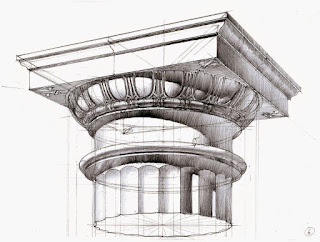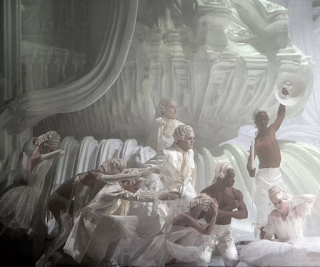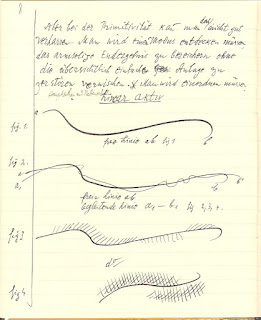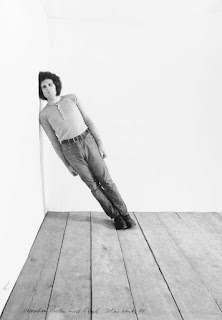To be a good artist is to be an animist. Well sometimes it feels that way. To be an artist you are supposed to be more self-aware, but there is a problem with being self-aware, it creates a sensation of isolation, that you are somehow detached from things, and the result of this is everywhere to see, a myopic view of the world that has resulted in a lack of empathy with not just all those things that are not human beings but with any human being who is not like how I think I am. Not being so self centred would entail being more aware of others, such as people who aren't me, as well as animals, plants, rocks, plastic bottles, water and gravity. Being less self conscious might also mean that I might eventually become "lonesome no more" as Kurt Vonnegut would put it, open to building friendships with stones, beetles and even other people who are not like me.
The dividing line between sentient life and lifeless 'matter' is not a clear one; the covid virus for example, is an infective agent that is a nucleic acid molecule in a protein coat that is able to multiply only within the living cells of a host. If self multiplication is a definition of life, a virus is a questionable life-form, having no powers of its own to duplicate itself. This particular formulation of matter has evolved to multiply itself by latching onto organic life. The important issue here being that if there is no clear dividing line between life and not-life, our membership of the world of things which is traditionally focused on organic life forms, now opens out to include all those inorganic things that exist in the world. Our understanding of things as being separate entities is also being questioned, (the virus cant exist on its own and neither can we) and we may eventually need to re-conceptualise ourselves and other things as interconnected events rather than as separate objects. This is possible because we have the imaginative capacity, the self being an idea, just as much as entanglement is an idea or time or events.
David Abram would argue that the imagination is an attribute of the senses themselves and that it is not a separate mental faculty. He states that what we call the imagination is "the way the senses themselves have of throwing themselves beyond what is immediately given, in order to make tentative contact with the other sides of things that we do not sense directly, with the hidden or invisible aspects of the sensible". In the same way that a virus has evolved to extend itself by developing an ability to latch onto bacteria, the senses have evolved in order to 'predict' the future. Events are constantly unfolding and everything in one way or another takes part in that tentative contact with other things, things that are really events. It is also salutary to remember that because of the complexity of interactions that the agents behind events are often hidden or invisible and our concern to always understand why or how things are as they are, is another aspect of our isolationist thinking, which leads to a belief that there are single identifiable causes behind everything.
Animism is a belief in an idea of interacting events rather than individually separated things. This shift in conceptual framework allows for a different type of awareness, whereby everything is experienced as not just being connected but in constant metamorphosis and flux.
We create personal relationships with pets, cuddly toys and all sorts of other objects, such as a lucky penny or memento from a holiday, because of these relationships, things become communicative subjects rather than inert objects. These approaches to the world begin to dissolve the idea that our environment consists of a physical world distinct from the world of people.
Nurit Bird-David states, "Animism is a "relational epistemology" rather than a failure of primitive reasoning. That is, self-identity among animists is based on their relationships with others, rather than any distinctive features of the "self". Instead of focusing on the essentialised, modernist self (the "individual"), persons are viewed as bundles of social relationships ("dividuals"), some of which include "superpersons" (i.e. non-humans)." (https://en.wikipedia.org/wiki/Animism#Postmodern_anthropology)
Tim Ingold is another contemporary theorist who argues that animists do not see themselves as separate from their environment. Ingold has written two books on lines, whereby he states that the line is a powerful metaphoric device that can be used to explain how entangled and interconnected everything is. So finally we get back to drawing, I wonder if the idea of things as communicative subjects rather than inert objects, can be applied to a reading of art objects, especially those art objects that have traditionally been regarded as 'special' things that have an 'aura' and that reside at the centre of Modernism? Let's see.
Léon Ferrari, Caminos
Centre Pompidou, Musée national d’art moderne, Paris
The drawing above by Léon Ferrari was exhibited in the exhibition 'Lines a Brief History' at the Musée national d’art moderne, Paris back in 2013. The exhibition was constructed around responses to Tim Ingold's writings, in particular his statement that, 'a study of men and things is a study of the lines of which they are made.' The exhibition had several overlapping sections, each one described as set out below in text copied directly from the Centre Pompidou website.
A taxonomy of lines
Artists have elaborated numerous taxonomies of the line, which is a major component of artistic creation. In the 1920s, for example, teachers at the Bauhaus classified types of line according to objective criteria. Whether the strictly geometrical straight line or a free-flowing meander, lines are always a powerful means of expression. The pure line is a constant in Minimal and Conceptual art. For proponents of action painting, influenced by Far Eastern philosophies, the line is a seismograph of the body in motion. Ramrod straight or swirling, single or multiple, the line in its many guises is inextricably linked to its means of production.
A page from Paul Klee's notebooks, which was exhibited in the taxonomy of lines section
Each section of the exhibition had within it artists that I hadn't encountered, which is perhaps one of the most interesting things about exhibitions put together by foreign curators. So I decided to look at the work of those artists that were totally new to me. The taxonomy of lines section included Karel Malich, Stanislav Kalibal, Francois Morellet and Lee Ufan, none of which I had come across before.
Karel Malich
As well as drawings, Malich worked in 3D, his wire drawings in space being very like extensions of drawings done on paper. He also worked in pastel, his very simple but intense abstract images being similar in feeling tone to 17th Century Rajasthan Tantric paintings. Stanislav Kalibal
Like Malich, Stanislav Kalibal was Czechoslovakian, his explorations of geometry reminded me of Kenneth Martin who taught occasionally at Newport when I was a student, however it was his trap drawings I was most interested in, I found a deep metaphorical connection with them and a link to other ideas I have held in the past about
geometry being a trap.
Francois Morellet
Francois Morellet was another European abstractionist I wasn't aware of. I found his more recent installations such as the red and blue wallpapered one above an interesting take on an area that is usually dominated by black and white and very restricted colour values and a way into thinking about the phenomenological reading of art.
Lee Ufan
For more on the related South Korean art group see: Dansaekhwa. The long poem of walking
In The Practice of Everyday Life (1980), the philosopher and historian Michel de Certeau describes walking, and its interaction with events and encounters along the way, as a “long poem”. This section considers how the line and the movement that makes it are one. Lines that “walk” across a sheet of paper or a reel of film leave a trace of their passage. Both trajectory and process, a drawing emerges from the progression of lines across the page. It is the continuous, physical movement of a line that forms a pattern in the back and forth motion of the hand; that traces the meanders we follow with our eye, or suspends and recomposes a trail to suggest an act in which the traveller and the line he makes are one and the same.
Julije Knifer
Knifer based his imagery from 1960 onward, on the use of just a single motif: the meander. With this, he created sculptures, reliefs, collages, large-format indoor and outdoor murals, artist's books, and diaries. The result is a virtually monolithic body of work, an approach I personally find impossible to contemplate, but which I know many art dealers and galleries like because it is very clear as to what you are getting and it links the artist to a very particular format, which can then be 'branded' and marketed as 'unique'.
Klaus Rinke
Klaus Rinke was an artist that I found more interesting, he reminded me of Vito Acconci or Bruce Nauman, his playful performance pieces also rather like Erwin Wurm's 'One Minute Sculptures', his work reminded me of the playfulness of art, or what is often called 'serious play'.
Léon Ferrari: Cidade
However it was Léon Ferrari that I found to be the most interesting artist in this section. These images were of plans for what he called an 'architecture of madness', spaces filled with anonymous characters behaving chaotically, representing the absurdity of modern city life and investigating the complex relationship between madness and order. Tracing boundaries, narrating experience
Like medieval maps that recorded the encounters travellers were likely to make, the different stages in the journey and how long it would take to walk between them, the works in this section are all “describers of itineraries.” (Michel de Certeau) As alternatives to abstract, conventional maps, these pencilled cartographies inscribe an experience or a journey. They record motion, flow and changes of direction. Their lines are the floating traces of a moving, subjective geography; illustrations of a territory lived first-hand. Through these interplays of lines, “a migrational, or metaphorical, city thus slips into the clear text of the planned and readable city.” (Michel de Certeau) The works can spring from poetic, political, exploratory, militant or subversive motivations.
Al Taylor
I have now broken my self imposed rule and have put up some images of Al Taylor's work. I have shown his work in one of my previous blog posts but he's always worth another look as I find him much more playful and often funny, as he works around the edge of seriousness. I suspect he has as the curators put it, 'subversive motivations' and I warm to that.
Till Roeskens
Till Roeskens is another artist well worth investigating, his video drawings or video mappings depict people caught in a situation that becomes more absurd every day. As people try to live a normal life in a refugee camp, it takes courage, craftiness and humour to survive. We are projected via his video into refugees' intimate experiences, while we follow the maps they draw to represent the complexity of the environment they experience.
Shusaku Arakawa: Diagrams for the imagination
Arakawa was an architect with a practice designed to prevent the inhabitants of his buildings from dying. His diagrammatic drawings are part of a body of work that is both strange and fascinating, his architectural designs based on ways to constantly keep the inhabitants thinking and 'on their guard' so that they never relax; relaxation being for Arakawa a weakness that would only result in an early death. Perhaps his drawings reminded me of Benjamin Brett's drawings of the shape of consciousness, for whatever reason, I was intrigued.
Space/measure
Geometry – literally “to measure the land” – is a branch of mathematics applied to a territory that is surveyed, contained, occupied and ultimately possessed by a line stretched between two points. The artists in this section envisage different ways of delimiting or redefining space; not in an authoritative way but using pencil, materials sourced in situ, or their own movements. Space, be it the space on a page, in nature, or inside the studio, is defined here on the scale of the artist’s body, trajectories and movement, and no longer by a fixed boundary. The body becomes a yardstick with which to measure the environment, highlighting the relative nature of accepted standards and offering scientificpoetic alternatives to the metric system.
Robert Mangold
Robert Mangold has several related themes that run through his work. The fragment in relation to the whole (how, for example, can a pie slice-shaped painting be read both as a section of an invisible circle and a form complete unto itself?); formal stability in relation to formal abnormality, and how does a surface assert its materiality while also suggesting transparency? All of these issues use geometry as a method of enquiry and the line as a device to visually slice through surfaces. Ghostly lines
From the curve of a branch to the contours of land carved by erosion; from the wind-sculpted ripples of dunes to the furrows man leaves in the earth, this section demonstrates the omnipresence of lines in nature. From the École de Paris to Minimalism, artists have represented this aspect of nature in landscapes reduced to abstraction. Ravines, geological movement and sinuous hillsides are stripped to their essence, to their vital force. In the 1960s, artists began to leave the studio and invent new forms on the scale of nature. Some inscribed lines on the landscape, using photography to record the invisible or reversible traces of their solitary path. Others saw themselves as demiurges, adding ephemeral lines to those of nature itself.
Toni Grand
Toni Grand's sculpture is often made of organic lines made in surprisingly 'inorganic' ways. Sometimes using natural materials, even eels, these materials can be cast into fibreglass or resin, the results being neither one thing or another, his 'lines' suggestive of natural forms, but hinting of artifice.
Vera Molnar
Vera Molnar’s computer-generated works used programming as a means to reflect upon the autographicity of the handmade trace in drawing and painting.
Writing
Whether handwritten or printed, writing is entirely composed of lines, of upstrokes and downstrokes which, combined into text, produce more lines that run across the page. These two facets of writing are a rich source of inspiration for the artists presented here. Letters and numbers, some barely legible, take over the page, the canvas, even a wall, replacing their primary function to communicate meaning with the aesthetic of a purely visual language. Other works, when not inventing languages, replace characters with abstract signs or endlessly repeated minimalist motifs, still conserving the alignment of text or musical notation.
Pierrette Bloch
Pierrette Bloch's work explores the abstract rhythms of mark making, each mark behaves like a sign, as in a written language, each mark being part of a field of marks that collectively can be read as asemic writing.
Lifelines
Like plants criss-crossed with nervures and cavities, the human body is made up of innumerable lines, beginning with the internal network of veins and arteries. The palm of the hand maps out our existence with lines whose meaning the fortune-teller has traditionally deciphered. This final section sets out correspondences between microcosm and macrocosm. They are reflected in the format of works which exaggerate a detail of the body, or in contrast propose a diminutive mapping of the individual. While life expectancy can be read in the lines of the hand, our fragile existence, on reaching its term, hangs by a thread: the ultimate metaphor of the line.
John Coplans
John Coplans' photographs highlight skin lines, his own body being at the time of taking the photographs of a similar age to my own, so I recognise the way that skin thins and forms age lines. I'm reflecting on an artist I already knew, so I break my self set rule again, but I had forgotten his work and now I'm making work about my own body and how I feel about it, his work has relevance to me in a way that it didn't before.
Hopefully by picking out artists that I hadn't come across before, the exercise was also useful to other people reading this post as an introduction to some artists that they hadn't come across before either. However I was also thinking about how a belief in animism could lead to an idea of thinking about the artworks in an exhibition as interacting events rather than individually separated things, and how these artworks could be seen as communicative subjects rather than objects waiting to be commented upon. I would like to think of each encounter with an artwork as being like a conversation; Coplans showing me his body as a sort of provocation, and myself replying that only after reaching a similar age am I ready to fully engage and entangle myself in his message, whilst Till Roeskens pulls me into the daily life of a refugee camp, a life that as I'm sucked into it, I realise I can never actually know, but can imagine now in far more detail than I ever did before. As in all communication, part of the reception of the work is dependent upon previous knowledge and proclivities; however all of these pieces, even the ones that I didn't find much empathy with, affected me in one way or another, and as they did they became enmeshed in my mind with all my other experiences and so they become like threads that are wound around me. As I write this post and you read it, these threads are wound around you as well, you now becoming entangled into my messy world, a world that includes stones and plants and insects as well as wind and rain and computers, atoms and quarks and electro-magnetic forces, as well as other people and ducks.
See also:
Asemic writing
Drawing and communication theory
Stitched, dashed or dotted lines
Tim Ingold

































































